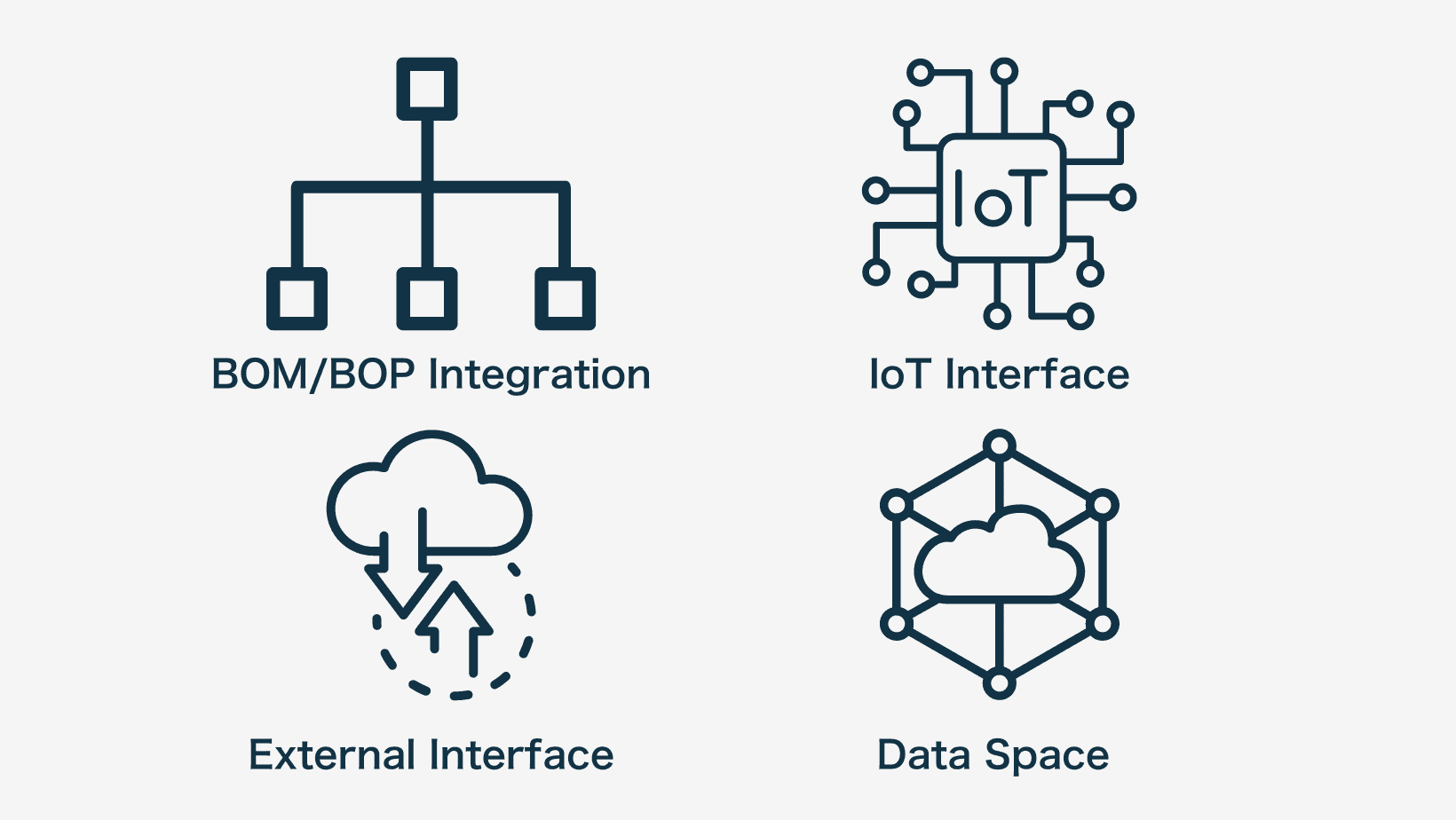SeizoMind CFP - CFP Platform
We integrate primary and secondary data to master data and operational records in order to manage the data needed for the CFP (Carbon Footprint of Products) calculation. This makes it possible to calculate CFP in accordance with rules and targets for reducing GHG emissions. Additionally, we guarantee data integration following industry standards.

Handling CFP in the Manufacturing Sector
The manufacturing sector has been attempting to cut CO2 emissions and power consumption in offices and factories in order to promote a sustainable society. Investors are now evaluating companies' efforts towards environmental sustainability, and these companies are being forced to disclose ESG (Environmental, Social, and Governance) information. The Carbon Footprint of Products (CFP) is one of the disclosed data items. As a result, accurate CFP measurement and management have become important processes in the manufacturing industry.
GHG (Green House Gas)
The term greenhouse gases (GHGs) describes the gases that cause climate change. These include gases that are released from manufacturing facilities, such as CO2, methane, nitrous oxide, and fluorinated gases. The company's direct data collection and standard values, such as industry averages from open databases or emission factors, are used to calculate emissions.
Primary data are those that are directly gathered by the business; secondary data are the typical data that is obtained from public databases. Primary data can be challenging to obtain because of financial or practical limitations, but it is more accurate and represents the company's actual conditions. When primary data is unavailable, secondary data can be used to calculate emissions; however, since it might not accurately reflect the company's unique activities, it can be more difficult to plan effective reduction strategies. Companies must therefore use a combination of primary and secondary data to calculate emissions.
CFP (Carbon Footprint of Products)
The term CFP (Carbon Footprint of Products) refers to the total greenhouse gas emissions during the whole lifecycle of a good or service, from the acquisition of raw materials to their disposal and recycling. These emissions are translated into CO2 equivalents and the product displays this value. Businesses can help mitigate climate change and improve their brand value in the eyes of investors and consumers by lowering CFP.
Challenges in CFP in manufacturing
The key challenges in CFP in manufacturing are as follows:
- Having challenges keeping track of the emission data
- Insufficient experience in deploying sensors
- Data exchange across the supply chain is necessary
Solution utilizing SeizoMind CFP
SeizoMind CFP provides an extensive feature set to facilitate the gathering and administration of primary data needed for CFP calculation. Companies can successfully manage CFP and actively accelerate their efforts to mitigate climate change by putting SeizoMind CFP into practice.
Having challenges keeping track of the emission data
It's crucial to account for supplier and other business partner activities in addition to your own company's operations when calculating emissions. Emissions from the supply chain at every stage should be divided into downstream, within-company, and upstream categories and gathered in compliance with the GHG Protocol. The information is then divided into three categories: Scope 1 (the company's direct emissions), Scope 2 (the indirect emissions resulting from the use of electricity, heat, or steam that was purchased), and Scope 3 (other indirect emissions not covered by Scope 2). Data collection reflecting the most recent operational realities is essential because manufacturing processes and supply chains are subject to frequent changes.
It's critical as well to update emission data collection and processing in accordance with modifications to parts or processes. Reconciling emission data with the most recent Bill of Materials or Bill of Process will be challenging if the company's actual operations are not accurately reflected in the emissions calculations. The credibility of public disclosures can be damaged by poor management of emissions data, which can also make it more difficult to implement emission reduction plans successfully. A proper alignment guarantees that your company can continue to pursue significant emissions reductions while also upholding transparency.
Functionality in SeizoMind CFP connects emission data to the BOM and BOP configurations in SeizoMind Mas. The system can instantly reflect the updated BOM or BOP even in the event of parts or process changes, guaranteeing that emission data is precisely collected for each product's manufacturing process. SeizoMind CFP can visualize emissions based on the actual parts used and by process stage in addition to calculating emissions by product, allowing for more efficient analysis and application of emission reduction strategies.
Insufficient experience in deploying sensors
The company's primary data collection is necessary to compute Scope 1 emissions. Transportation volumes, heat usage, and electricity consumption are commonly included in this primary data. Installing sensors, like power consumption monitors, on equipment is necessary to measure emissions for every piece of machinery or process precisely. This makes it possible to precisely track and report emissions related to the direct operations of the company.
Since every piece of equipment has unique requirements, there are differences in the methods used to measure power consumption. It is necessary to have knowledge of communication protocols, data formats, and data storage in addition to the physical aspects of sensors. The setup and installation of these systems can be very expensive when trying to measure power consumption across a large number of machines and equipment on the factory floor. For efficient emission monitoring and management, this covers not only the installation of sensors but also the data's integration into the company's current systems.
Utilizing SeizoMind CFP and SeizoMind Tra together, companies can construct power and heat measurement systems with ease. The platform offers interfaces for incorporating both popular sensors and ones users have previously requested. SeizoMind CFP can easily integrate the data and take into account the differences between different types of sensors being used at the same time. SeizoMind also provides advisory services for the selection and application of sensors, assisting users in effectively configuring their systems.
Data exchange across the supply chain is necessary
It is necessary to exchange emissions data along the supply chain in order to calculate the CFP. Spreadsheets in Excel are sometimes used to share this data. Accurately gathering emissions data calls for communicating with a large number of companies associated with your products, including suppliers, delivery partners, and various contractors. Getting thorough and accurate emissions data requires setting up effective communication and data-sharing procedures with these organizations.
Data aggregation takes a lot of work when every company uses a different format for data sharing. This is particularly true for vendors of parts and materials, who frequently have to comply with the demands of their clients, who are usually makers of final products. Consequently, they have to handle various data formats and integration techniques, which adds to the complexity and duration required for appropriate data exchange and administration throughout the supply chain.
Data sharing functionality compliant with industry standards and regulations is offered by SeizoMind CFP. The Ouranos Ecosystem is one such project that aims to increase CFP traceability in the battery and automotive industries. In order to support the effectiveness of CFP data-sharing operations, SeizoMind CFP has quickly implemented an interface with the data integration platform realized within the Ouranos Ecosystem.
Toward the Success of CFP management
One of the most important tools for advancing efforts toward a sustainable society is CFP management. Companies can significantly enhance their CFP management processes by properly collecting primary data from the manufacturing floor and integrating it with master data, which is required for CFP computations. A company can establish itself as a leader in CFP management and drive the supply chain by adopting an early approach to data sharing within the supply chain. For companies wishing to implement CFP management processes or enhance their current ones, SeizoMind CFP is the best option.
As introduced in this article, implementing SeizoMind CFP can lead to the following benefits:
- Obtaining emission estimates that correspond with actual operations
- Improving the precision of the emission analysis
- Lowering the work involved in implementing sensors
- Lowering the work involved in creating emission calculation logic
- Simplifying CFP management duties
- Adherence to data-sharing guidelines throughout the supply chain
- Enhancing the company's position in the supply chain
If you are experiencing difficulties with CFP management or related operations, we advise you to consider our SeizoMind-based solutions. For more extensive information, pricing, or casual consultations, please use the contact form on our website.


